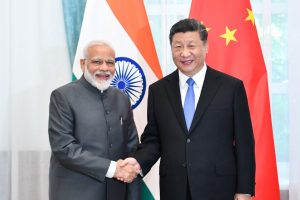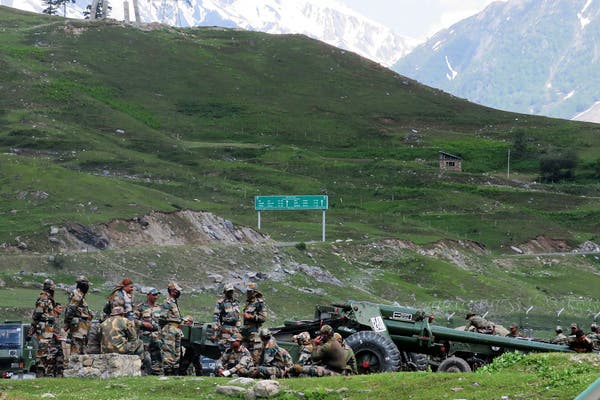K.M. SEETHI
First published in Global South Colloquy, 18 June 2020
The Galwan valley encounter between India and China, which took an unanticipated but a significant number of casualties on both sides, is certainly a major setback for India’s good neighbour policy and its national security architecture. The sudden reversal came even as the entire nation immersed itself in ensuring human security in the context of Covid-19 since the third week of March 2020. In the wake of the showdown on 15 June 2020, Prime Minister Modi has given a clear signal to Beijing that India cannot afford to make any compromise on its territory and political sovereignty, but it would go to any extend in avoiding a direct military confrontation. He, however, said: “India will firmly protect every inch of the country’s land and its self-respect” (PMINDIA 2020).
India’s External Affairs Minister (EAM) S. Jaishankar, in his conversation with his counterpart Wang Yi, conveyed the protest of the Government “in the strongest terms on the violent face-off in Galwan Valley.” Recalling that the meeting of senior Military Commanders held on 6 June had reached an agreement on de-escalation and disengagement along the Line of Actual Control (LAC), he said that this “unprecedented development” in violation of the agreement would have “a serious impact on the bilateral relationship.” EAM noted that while there was some progress in negotiations after the agreement, the Chinese military “sought to erect a structure in Galwan valley on our side of the LAC.” While this emerged as a source of dispute, the Chinese “took pre-meditated and planned action that was directly responsible for the resulting violence and casualties.” EAM said that “it reflected an intent to change the facts on ground in violation of all our agreements to not change the status quo.” The Minister reminded that the “need of the hour was for the Chinese side to reassess its actions and take corrective steps. The two sides should scrupulously and sincerely implement the understanding that was reached” by the Senior Commanders on 6 June. Troops of both sides should also abide by the bilateral agreements and protocols (India, MEAa). The Foreign Minister of China conveyed the Chinese position on these developments. It was agreed that the “overall situation would be handled in a responsible manner, and both sides would implement the disengagement understanding of 6 June sincerely. Neither side would take any action to escalate matters and instead, ensure peace and tranquillity as per bilateral agreements and protocols” (Ibid).

It is evident that the Modi Government has been very positive and practical in dealing with China in the recent past. In October 2019, Prime Minister Modi and Chinese President Xi Jinping had held an informal summit in Mamallapuram, Tamil Nadu, after the talks in Wuhan in the wake of the 2017 Doklam standoff. Many, however, tended to believe that the ground situation across India-China border continued to be delicate. Even as both countries have been fully absorbed in grappling with the global pandemic and its short-term and long-term implications, not many would have expected a major setback in bilateral relations. Even in the midst of the Covid-19 pandemic, the leaders of both countries at the highest level were positive and mutually reassuring the complementarity of relations. For example, in the context of the 70th Anniversary of the establishment of diplomatic relations between India and China, Prime Minister Modi, in his message to the Chinese Premier Li Keqiang, underlined that India and China being “ancient civilizations with a long history of mutually beneficial exchanges over centuries” “are increasingly playing an important role on the global landscape.” He said that “good relations between India and China are conducive not only for our respective countries, but are also important from the perspective of peace, stability and prosperity of our region and the world.” Prime Minister also noted that “the COVID-19 pandemic was a reminder to us of the interconnected nature of our world today and the need therefore to adopt a truly global response to it” and that he looked forward to working with the Chinese Premier to “further deepen and strengthen our Closer Developmental Partnership and take it to even greater heights in the years to come” (India, Ministry of External Affairs 2020b). Hardly a fortnight before this, the Minister of State for External Affairs told the Lok Sabha that it had provided 15 tonnes of medical assistance comprising masks, gloves and other emergency medical equipment to China on 26 February 2020. These supplies were delivered “as a mark of friendship and solidarity from the people of India towards the people of China as the two countries also celebrate 70th anniversary of establishment of diplomatic relations this year” (India, Ministry of External affairs 2020c).
The border dispute between Asia’s two giants has a history which spanned over seven decades. Much of what the Nehru and post-Nehru governments could not tackle since 1950s bequeathed to the Modi government today, and the opposition, particularly the Indian National Congress, made no hesitation in taking the current dispensation to task for its “lapses” and “hesitation” in dealing with China. This is actually masquerading history and, in fact, the greatest lapses had come during the Nehru and Indira Governments in the early 1960s (including the 1962 war) – the 1967 incursions, the 1975 encounters and, of course, the Sumdorong Chu episode in 1986-87 during Rajiv Gandhi’s period (Seethi1997: 99). It was also Rajiv Gandhi who took further steps in improving relations with China after his visit in 1988. One of the major results of the visit was the setting up of Joint Working Group (JWG) to deal with the boundary question. The improvement in bilateral relations came in the post-cold war period, particularly after the launching of India’s economic liberalisation and China’s entry into the world economic fora, including the World Trade Organisation (WTO) which significantly enhanced India’s trade and economic cooperation with China. Both India and China knew each other as co-partners in economic and technological cooperation. Over years, China emerged as India’s top trade partner notwithstanding the widening trade deficit for the latter. Obviously, this emerging dynamics of trade and economic partnership would have surprised many in the West who were evidently concerned about the ‘peaceful rise’ of China. US President Donald Trump is an epithet of this anti-China ‘dirty’ coalition under the Indo-Pacific reincarnation (Seethi 2018; Seethi 2019). Though India has been co-opted within this coalition, with a ‘carrot and stick formula’ of Trump-circle, the Modi Government went on sustaining a flexible coalition dynamic by putting its eggs in different baskets like BRICS, SCO etc. New Delhi knew very well that in the emerging global economic architecture, it cannot afford to alienate the countries of the Global South and the post-socialist world. Hence, it would be natural and inevitable that the Modi Government has been committed to maintaining a reasonable sequence of friendship and cooperation with China and other countries in Asia. However, this cannot be viewed as India’s ‘weakness’ given the multitude of issues at the regional and international levels. China knows that there is a burgeoning demand in India for putting all eggs in Washington’s basket. China’s state-owned Global Times editorial on 17 June is very clear on this: “We noticed that in recent years, favourable opinion toward China has rarely been heard from India, but voices that cater to the values-based alliance and the Indo-Pacific Strategy are becoming louder. Can these provide strong strategic support to India’s desire to rise? These concepts dominated by the US implicitly target China, and Washington needs a country like India to spearhead attacks on China” (GT 2020). The editorial further says: “China and India must be capable of properly handling the border disputes. No ties between India and other countries can take the place of India-China relations. New Delhi can never unilaterally resolve the border disputes with Beijing, and it will never realize the prosperity it desires if its 2,000-kilometer border with China is repeatedly marked by clashes.” “The phone call between the Chinese and Indian foreign ministers on Wednesday will help ease the situation. While they expressed their stance, they also set the tone for easing the situation, which will direct public opinion in their own countries” (Ibid). It is a good sign that the two countries have started engaging each other diplomatically, at the highest level, with a positive mindset. Leaving the armies themselves to ‘settle score’ won’t be a solution to the perennial boundary question. Different tracks should be set open for a smooth handling of all issues of the boundary question. The JWG should be expanded further with additional responsibilities for tackling new problems that loom large in India-China negotiations. The first and foremost thing that both countries should bear in mind is that the worst enemy is still around us with its killer-mechanism operating beyond boundaries which has already taken a heavy toll, with its long-term consequences for the human survival. Coronavirus has, at least, taught a lesson that human-made boundaries have no meaning when humans themselves are at high risk of a global pandemic.
References
GT (2020): “Border peace basis for healthy China-India ties: Global Times editorial,” The Global Times, 17 June, https://www.globaltimes.cn/content/1191967.shtml.
India, Ministry of External Affairs (2020b): “Phone call between External Affairs Minister, Dr. S. Jaishankar and Foreign Minister of China, H.E. Mr. Wang Yi, 17 June, https://www.mea.gov.in/press-releases.htm?dtl/32765/Phone_call_between_External_Affairs_Minister_Dr_S_Jaishankar_and_Foreign_Minister_of_China_HE_Mr_Wang_Yi
India, Ministry of External Affairs (2020b): “70th Anniversary of the Establishment of Diplomatic Relations between India and China, 1 April, https://www.mea.gov.in/press-releases.htm?dtl/32608/70th+anniversary+of+the+establishment+of+diplomatic+relations+between+india+and+china
India, Ministry of External affairs (2020c): “answer by the minister of state in the ministry of external affairs to Question No. 4031(LOK SABHA) on the Relief material to China” 18 March, https://www.mea.gov.in/lok-sabha.htm?dtl/32549/question+no+4031+relief+material+to+china
PMINDIA (2020): “PM’s remarks on the situation in India-China Border areas,” 17 June, https://www.pmindia.gov.in/en/news_updates/pms-remarks-on-the-situation-in-india-china-border-areas/?comment=disable
Seethi, K.M. (1997): “India-China Relations in the 1990s,” in K. Raman Pillai (ed), India’s Foreign Policy in the 1990s, New Delhi: Radiant.
Seethi, K.M. (2019): “A New ‘Washington Consensus’: Indo-Pacific and India’s Emerging Role,” Economic and Political Weekly, 23 February.
Seethi, K.M. (2018): “India’s Emerging Role in the Indo-Pacific: Rise of Sub-imperialism?” Countercurrents, 2 August



